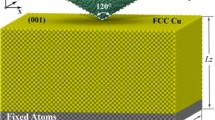Abstract
The mechanical properties of materials are fundamentally derived from the microscopic structures and their behavior, and nanoindentation testing is widely used in fundamental studies of microscopic plasticity in materials. However, it is difficult to capture the plastic deformation phenomena moment by moment in experiments. For this issue, molecular dynamics (MD) simulation is a useful tool for visualizing atomistic behavior in materials. To cultivate a better understanding the elementary process of microscopic plastic deformation, in this study, we conducted nanoindentation MD simulation for body-centered cubic (BCC) iron (Fe) and hexagonal close-packed (HCP) magnesium (Mg) and visualized the initiation of plastic deformation, that is, dislocation nucleation. Furthermore, displacement burst events, called “pop-in,” are observed in nanoindentation and well-known as catastrophic events which result from dislocation nucleation. Here, we also predicted the temperature dependency of first pop-in load based on nanoindentation MD simulation for HCP Mg. Compared to the prediction result for BCC Fe in our previous study, the temperature dependence for Mg is much smaller than that for Fe.
Access this chapter
Tax calculation will be finalised at checkout
Purchases are for personal use only
Similar content being viewed by others
References
Gleiter, T.: Nanostructured materials: basic concepts and microstructure. Acta Mater. 48(1), 1–29 (2000)
Schuh, C.A.: Nanoindentation studies of materials. Mater. Today 9(5), 32–40 (2006)
Sutton, A.P., Pethica, J.B.: Inelastic flow processes in nanometre volumes of solids. J. Phys.: Condens. Matter 2(24), 5317–5326 (1990)
Gerberich, W.W., Nelson, J.C., Lilleodden, E.T., Anderson, P., Wyrobek, J.T.: Indentation induced dislocation nucleation: the initial yield point. Acta Mater. 44(9), 697–702 (1996)
Minor, A.M., et al.: A new view of the onset of plasticity during the nanoindentation of aluminium. Nat. Mater. 5(9), 697–702 (2006)
Gouldstone, A.V., Vliet, K.J., Suresh, S.: Simulation of defect nucleation in a crystal. Nature 411, 656 (2001)
Van Vliet, K.J., Li, J., Zhu, T., Yip, S., Suresh, S.: Quantifying the early stages of plasticity through nanoscale experiments and simulations. Nature 67, 104105 (2003)
Ruestes, C.J., Alhafez, I.A., Urbassek, H.M.: Atomistic studies of nanoindentation-a review of recent advances. Crystals 7(10), 293 (2017)
Ohmura, T., Wakeda, M.: Pop-In phenomenon as a fundamental plasticity probed by nanoindentation technique. Materials 14(8), 1879 (2021)
Sato, Y., Shinzato, S., Ohmura, T., Hatano, T., Ogata, S.: Unique universal scaling in nanoindentation pop-ins. Nat. Commun. 11, 4177 (2020)
Schuh, C.A., Lund, A.C.: Application of nucleation theory to the rate dependence of incipient plasticity during nanoindentation. J. Mater. Res. 19(7), 2152–2158 (2004). https://doi.org/10.1557/JMR.2004.0276
Schuh, C.A., Mason, J.K., Lund, A.C.: Quantitative insight into dislocation nucleation from high-temperature nanoindentation experiments. Nat. Mater. 4(8), 617–621 (2005)
Mason, J.K., Lund, A.C., Schuh, C.A.: Determining the activation energy and volume for the onset of plasticity during nanoindentation. Phys. Rev. B 73(5), 054102 (2006)
Sato, Y., Shinzato, S., Ohmura, T., Ogata, S.: Atomistic prediction of the temperature- and loading-rate-dependent first pop-in load in nanoindentation. Int. J. Plast 121, 280–292 (2019)
Aghion, E., Bronfin, B., Eliezer, D.: The role of the magnesium industry in protecting the environment. J. Mater. Process. Technol. 117(3), 381–385 (2001)
Hirel, P.: Atomsk: a tool for manipulating and converting atomic data files. Comput. Phys. Commun. 197, 212–219 (2015)
Mendelev, M.I., Han, S., Srolovitz, D.J., Ackland, G.J., Sun, D.Y., Asta, M.: Development of new interatomic potentials appropriate for crystalline and liquid iron. Phil. Mag. 83(35), 3977–3994 (2003)
Wu, Z., Francis, M.F., Curtin, W.A.: Magnesium interatomic potential for simulating plasticity and fracture phenomena. Mater. Today 23(1), 015004 (2003)
Plimpton, S.: Fast parallel algorithms for short-range molecular dynamics. J. Comput. Phys. 117(1), 1–19 (1995)
Henkelman, H., Jónsson, H.: Improved tangent estimate in the nudged elastic band method for finding minimum energy paths and saddle points. J. Chem. Phys. 113(22), 9978 (2000)
Fan, Y., Osetsky, Y.N., Yip, S., Yildiz, B.: Onset mechanism of strain-rate-induced flow stress upturn. Phys. Rev. Lett. 109(13), 133503 (2012)
Linstrom, P.J., Mallard, W.G.: NIST Chemistry WebBook, NIST Standard Reference Database Number 69 (2003). http://webbook.nist.gov. Retrieved 1 Nov 2004
Stukowski, A.: Visualization and analysis of atomistic simulation data with OVITO-the Open Visualization Tool. Modell. Simul. Mater. Sci. Eng. 18(1), 015012 (2010)
Akhtar, A., Teghtsoonian, E.: Solid solution strengthening of magnesium single crystals-I alloying behaviour in basal slip. Acta Metall. 17(11), 1339–1349 (1969)
Chapuis, A., Driver, J.H.: Temperature dependency of slip and twinning in plane strain compressed magnesium single crystals. Acta Mater. 59(5), 1986–1994 (2011)
Acknowledgement
Y. S. acknowledges the financial support from the AMADA Foundation (AF-2021038-C2). Y. S. and J. Y. would like to thank Mr. Tomohiro Uchida for helping the execution of the simulations. Simulations in this work were performed on Wisteria/BDEC-01 at the Information Technology Center, The University of Tokyo and OCTOPUS at the Cybermedia Center, Osaka University.
Author information
Authors and Affiliations
Corresponding author
Editor information
Editors and Affiliations
Rights and permissions
Copyright information
© 2024 The Author(s), under exclusive license to Springer Nature Switzerland AG
About this paper
Cite this paper
Sato, Y., Shinzato, S., Ohmura, T., Hatano, T., Yanagimoto, J., Ogata, S. (2024). Molecular Dynamics Simulation on the Initiation of Plastic Deformation by Nanoindentation. In: Mocellin, K., Bouchard, PO., Bigot, R., Balan, T. (eds) Proceedings of the 14th International Conference on the Technology of Plasticity - Current Trends in the Technology of Plasticity. ICTP 2023. Lecture Notes in Mechanical Engineering. Springer, Cham. https://doi.org/10.1007/978-3-031-42093-1_45
Download citation
DOI: https://doi.org/10.1007/978-3-031-42093-1_45
Published:
Publisher Name: Springer, Cham
Print ISBN: 978-3-031-42092-4
Online ISBN: 978-3-031-42093-1
eBook Packages: EngineeringEngineering (R0)




